Learn the basics of Variable Frequency drives- how they work, why they are used and their importance along with worked examples.
Scroll down to the bottom to watch the Youtube tutorial.
Remember electricity is dangerous and can be fatal. You should be qualified and competent to carry out any electrical work.
If you work in HVAC, then you need to check out the inverter compressors by Danfoss, who have kindly sponsored this topic. When used in combination with variable speed technology, like the VFDs we’re going to cover in this article, they make your entire HVAC unit more efficient, saving you and your customers money.
🎁 Check out the free Danfoss elessons and case stories HERE
What is a VFD

VFD stands for Variable Frequency Drive and they look something like this. You might also hear them referred to as AC drives, or variable speed drives, because they are used to control the rotational speed of an AC motor.

We find AC motors and VFD’s used in all industries, especially HVAC. For example we can find them used to control a compressors speed in a refrigeration system which allows us to closely match the cooling demand and that results in significant energy savings. Traditionally we would have had to use fixed speed compressors which simply turn on and off resulting in poor control and high inrush currents.

We also find them used to control things like pumps and fans in HVAC systems to also unlock energy savings, improve performance and control.

The VFD unit is connected into the motors electrical supply. The unit can vary the frequency of the electricity being supplied to drive the motor and by varying this we can control the rotational speed of the motor. Therefore, we have our variable frequency drive.

To understand how a VFD works we first need understand some fundamentals of electricity.
Direct current
There are two types of electricity and the first one we’ll look at is DC or direct current. This is the simplest type and we get this from batteries, solar panels etc.

You can think of DC like a river, with a current of water flowing in just one direction.
With DC, the electrons just flow in a single direction. We’re animating this using electron flow which is from negative to positive, but you might be used to seeing conventional current which is from positive to negative. Electron flow is what’s actually occurring, conventional was the original theory. Just be aware of the two theories and which one we’re using.

For electricity to flow we need to complete the circuit. The electricity will then always try to get back to its source.
When we use an oscilloscope to look at the electrical wave form for DC, we get this flat line at maximum voltage in the positive region.

If we cut the power, the line drops to zero.

If we turn it on and off repeatedly then we get a square wave pattern between zero and maximum.

If we pulsed the switch to open and close over different lengths of time then we get a pulsating pattern.

Alternating Current

The other type of electricity is AC or alternating current. This type is what you will get from the outlets in your homes and places of work. With this type of electricity, the electrons within the copper wire constantly reverse and flow forwards and backwards, forwards and backwards etc.
You can think of this type like the tide of the sea which flows in and out between two maximum points.
If we followed the copper wires back to the generator, the wires are connected to some coils of wire which sit within the generator. Inside a basic generator we also find a magnet at the centre which is rotating.

The magnet has a north and south pole or you can think of it as a positive and negative half. The electrons in the wire are negatively charged. As you might already know, magnets push or pull depending on the polarity. As the magnet rotates past the coils, the positive and negative half are going to therefore push and pull the electrons within the copper coils and also through the connected copper wires.

The magnetic field of the magnet varies in intensity. So as the magnet rotates past the coil, the coil will experience a change in intensity of the magnetic field, from zero, up to its maximum intensity and then as it passes the coil, it will decrease again back to zero.



Then the negative half comes in and pulls the electrons backwards with the same change in intensity. Each full rotation of the magnet will therefore produce this wave pattern known as a sine wave. The voltage is not constant in this type of electricity and it instead repeatedly moves from zero, up to its peak, back to zero, then to the negative peak and finally back to zero.
Frequency

Frequency refers to how many times this AC sine wave repeats per second.

In north America and a few other parts of the world we find 60Hz electricity at the outlets which means the sine wave repeats 60 times per second and as each wave has a positive and negative half, this means its polarity will therefore reverse 120 times per second.

In the rest of the world we mostly find 50 Hz electricity so the sine wave repeats 50 times per second and therefore the current reverses 100 times per second.
Single phase and three phase electricity
We also have single phase and three phase electricity. With single phase we have a connection to just a single phase from a generator, so we have just one sine wave.

But with three phase electricity we have a connection to each of the three phases. The phases are coils of wire which are inserted into the generator 120 degrees apart from the previous, this means the coils experience the peak of the rotating magnetic field at different times, this gives us our three phases, each with a different sine wave.

Remember electricity wants to get back to its source in a complete circuit. As the current is flowing forwards and backwards at different times in each of the phases, we can essentially connect the phases together and the current will move between the different phases as the polarity of each phase moves forwards and backwards at different times. Any excess will flow in the neutral back to the source if needed.

With single phase we have these large gaps between the peaks. But with 3 phase these can be combined to fill the gaps in and therefore deliver more power.

In north America you will find a split phase system with two hot wires and a neutral. This is a single-phase supply which is split in half at the transformer, we’ve covered that in great detail previously, find out more HERE.
Basic Parts of a VFD

We install the VFD into the power supply of an AC motor. This is usually a 3 phase supply for most applications. We’re going to colour these phases in Red, Yellow and blue because we think it’s easier to see, but each country uses a different colour code. Just be aware of this.

The three phases enter the VFD and connect to the rectifier. The rectifier consists of multiple diodes connected in parallel.

Diodes only allow electricity to flow in one direction and block it coming back in the opposite direction. As AC flows forwards and backwards, we control the path it can take and this gives us a rough DC output.

The rough DC electricity flows into the second part which is the DC bus.

This is a filter that uses capacitors and or inductors to smooth out the rectified-DC into a clean, smooth, constant DC voltage. It releases electrons during the gaps to smooth the ripple out.

The smooth DC then flows into the final section which is the inverter. The inverter consists of a number of electronic switches known as IGBT’s. These open and close in pairs to control the flow of electricity. By controlling the path which the electricity takes and how long it flows in the different paths, we can produce AC electricity from the DC source. Let’s look now in detail at each part.
How a VFD Works
We will consider the first part of the VFD which is the rectifier. In this part we find 6 diodes in parallel, we’ll title these 1-6 as follows.

Each of the three phases is connected to one pair of diodes. As we know, electricity needs to get back to its source to complete the circuit. So, in this setup the current will flow through the load and back to the source using another phase. It can do this because the current in each phase flows forwards and backwards at different times, we’ll see this in detail in just a moment. The load can be anything, a lamp, a motor or an entire circuit. In this case it will represent the rest of our VFD circuit.

The electricity will continue to alternate in the supply phases, but the diodes will only allow the peak phase to pass and will block the others, so we’ll animate these. Lets see this in action.

Phase one is first, this comes in and can only flow in one direction, which is through diode 1. It then passes through the load. Once the current passes through the load, it will then need to get back to the source and as phase 2 is in the negative half of its cycle, the current will flow through diode 6 into phase 2.
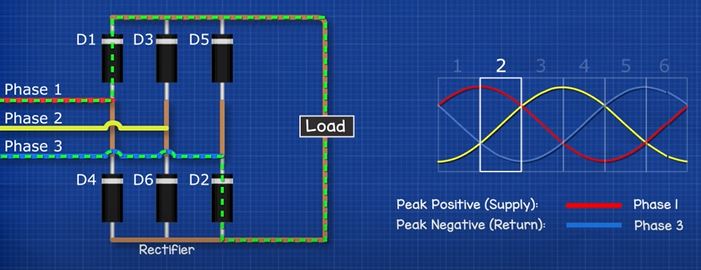
Phase 2. The next segment we see the current is still flowing in phase 1 and diode 1, but now phase 3 is in its negative half so the current switches and the flow returns through this phase via diode 2.

Phase 3. In the next segment, phase 2 is approaching it’s peak so the current now flows in this phase through diode 3, through the load and back into phase 3 via diode 2.

Phase 4. In the next segment, the current flows still in phase 2 via diode 3, but phase 1 is now at its negative peak so the current will flow through diode 4 back into phase 1

Phase 5. In the next segment we see phase 3 is now approaching its positive peak so the current flows through this phase via diode 5, through the load and then returns via diode 4 into phase 1
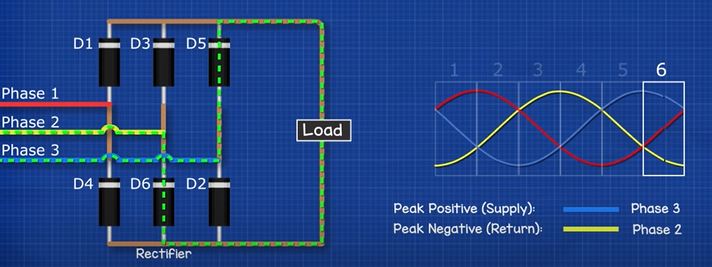
Phase 6. Finally, the current flows through phase 3 via diode 5, through the load and then back into phase 2 via diode 6.
This cycle repeats constantly like this.
The oscilloscope of the 3 phase supply will see three sine waves for the AC electricity. But the oscilloscope on the load will see this rough DC electricity with some ripples in it.

Now we need to smooth out those ripples to clean up the DC electricity. For this we connect a capacitor across the positive and negative. This capacitor is like a storage tank and will absorb electrons when there is an excess, and it will inject electrons when there is a reduction.

This will smooth out the DC electricity into a nice smooth signal on the oscilloscope.
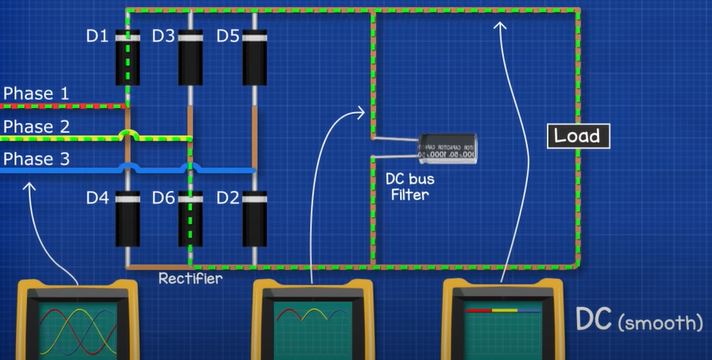
We’ve covered capacitors in great detail previously, do check that out HERE.
Now that we have clean DC we’re ready to turn it back into precisely controlled AC at variable frequency. For that we need an inverter. This is basically a number of IGBT’s, which are switches that can turn on and off super-fast. We’re going to animate these using simple switches instead of IGBT’s to make it easier to visualize. We’ll number these switches as follows.

To get our three phases, we need to open and close switches in pairs to direct the flow of current to form our supply and return paths, that way the connected motor will experience Alternating current.

Remember AC is when the current reverses. So, if we took a lamp and connected it to some switches and a DC power source. We can control the direction of current through the lamp by opening and closing switches in the right order. Therefore, the lamp experiences Alternating current, even thought it’s coming from a DC supply.
For the three-phase supply, we time the switches to simulate the 3 phases. Let’s see how this works.

First we close switches 1 and 6. This will give us phase 1 to phase two.

Then we close switches 1 and 2. This will give us phase 1 to phase three.

Then we close switches 3 and 2. This will give us phase 2 and 3

Then we close switches 3 and 4. This will give us phase 2 and 1.

Then we close switches 5 and 4. This will give us phase 3 and 1

Then we close switches 5 and 6. This will give us phase 3 and 2.

This cycle repeats again and again. If we check this with the oscilloscope, we will now have a wave pattern that looks like AC, except it’s a little bit square. This will work fine for some applications but not all, so how can we improve this.

Remember earlier in the article when we said we can open and close the switch at different speeds and duration’s to change the wave form. We’ll we can do that for this too.

What we do is use the controller to rapidly open and close the switches multiple times per cycle in a pulsating pattern, each pulse varying in width. This is known as pulse width modulation. The cycle is broken up into multiple smaller segments.
Each segment has a total amount of current that could flow. But by rapidly pulsating the switches we control the amount of flow occurring per segment. This will result in an average current per segment which we see increases and decreases thus giving us a wave. The load will therefore experience a sine wave.
We can control the output voltage by controlling how long the switches are closed for. So we could for example output 240v or 120v by trimming the open and close times.

We can control the frequency by controlling the timing of the switches, so we could for example output 60hz, 50hz or 30Hz, whatever is needed for the application. By controlling the frequency, we control the rotational speed of the motor.
So coming back to our VFD circuit, we are going to use the controller to rapidly open and close the switches to vary the output frequency and voltage.

So by combining the rectifier, the filter and the inverter we therefore get our variable frequency drive which can be used to control the speed of electrical motors.

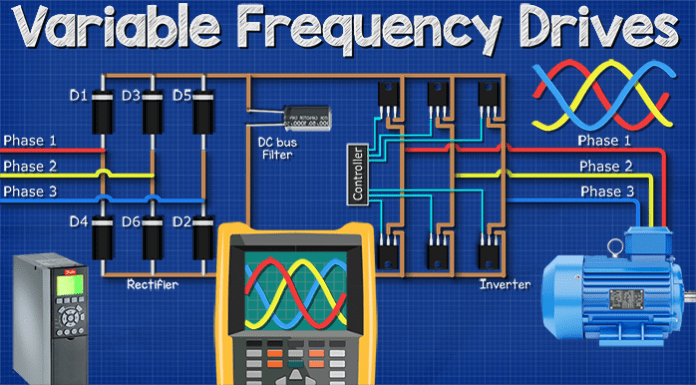



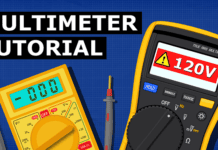
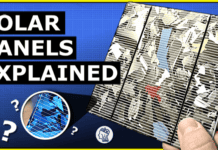
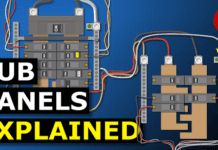
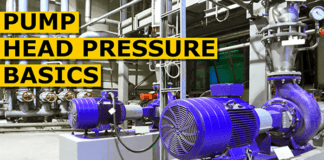
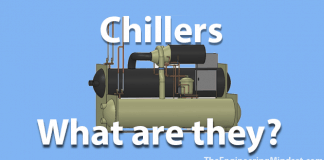
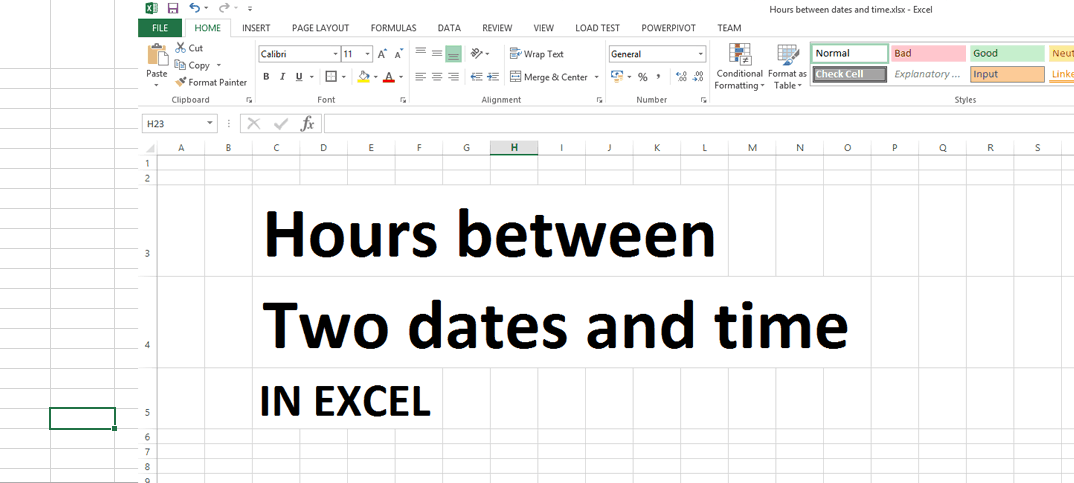
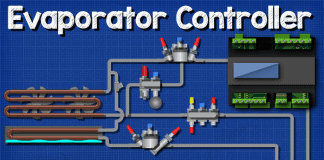
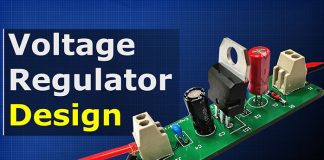
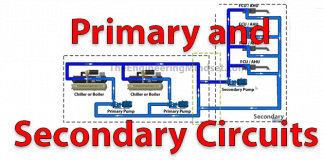
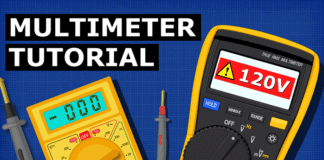







I am an electrical engineer,really it is too helpful and informative website.Thanks you
Great explanation Paul
I don’t know if it’s just me or if perhaps everybody else experiencing problems with your blog. It appears like some of the text on your content are running off the screen. Can somebody else lease comment and let me know if this is happening to them as well? This might be a issue with my browser because I’ve had this happen before.
We had an issue with some old code on some pages with a recent update. If you find a page with issues please send us an email to report the problem. Thanks!
Really its very informative video. Very helpful for new engineers and seniors.
[…] By the way we have covered, variable frequency drives, motor starters and solenoid valves in detail in our previous articles. Check them out HERE. […]
[…] VFD has 3 main components that allow the unit to output the frequency required for the […]
Thanks for your information.
[…] MORE HERE: https://theengineeringmindset.com/variable-frequency-drives-explained/ Sign up for our FREE engineers newsletter for updates, competitions, news and offers 🎁 Link: […]